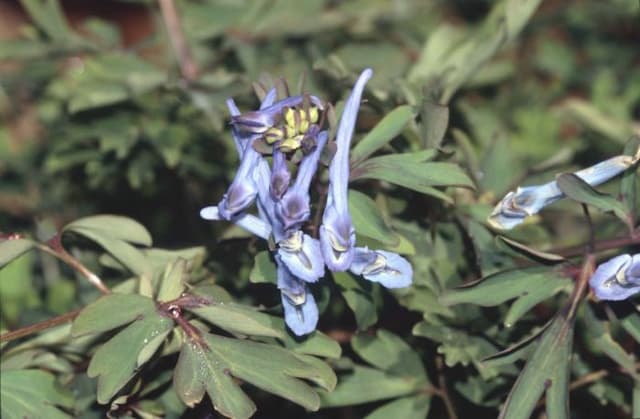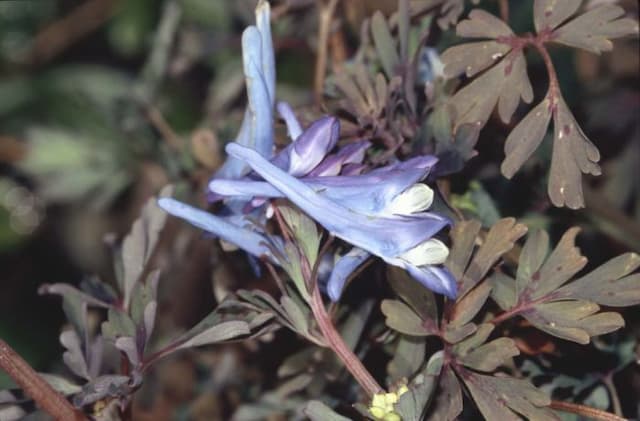Fumewort Corydalis 'Korn's Purple'

ABOUT
The Corydalis 'Korn's Purple' is a captivating ornamental plant primarily known for its attractive, delicate foliage and vibrant flowers. It boasts a clump of fern-like, blue-green leaves that provide a soft, finely textured backdrop to the flowers. The plant produces an abundant display of tubular blossoms, which are a striking shade of purple, often with a touch of blue or magenta that adds depth to the color. The blooms are arranged in graceful racemes, which taper to a tip, resembling a hovering swarm of colorful butterflies above the foliage. Its flowers have a distinctive spurred shape, giving it a whimsical, fairy-like appearance. The combination of the feathery leaves and vivid, purple flowers makes Corydalis 'Korn's Purple' a standout in any garden setting, providing visual interest and attracting pollinators such as bees and butterflies. The plant typically blooms in the cooler weather of spring and fall, adding color and life to the garden during these times.
About this plant
 Names
NamesFamily
Papaveraceae
Synonyms
Korn's Purple Corydalis, Fumewort
Common names
Corydalis 'Korn's Purple'.
 Toxicity
ToxicityTo humans
Corydalis 'Korn's Purple', commonly known as Fumewort, is not known to be highly toxic to humans. However, like many plants, it may cause some degree of discomfort if ingested, potentially resulting in symptoms such as nausea, vomiting, or diarrhea. It is always advisable to avoid eating ornamental plants due to the possible presence of toxic compounds and the risk of an allergic reaction. If any part of the plant is ingested, it is recommended to seek medical advice.
To pets
Fumewort is not specifically listed as highly toxic to pets. However, as a general precaution, it is not recommended for pets to ingest ornamental plants. While it may not be severely poisonous, ingestion can potentially lead to gastrointestinal upset in pets, such as vomiting or diarrhea, especially if consumed in large quantities. If you suspect your pet has ingested this plant, observe for any signs of distress and consult with a veterinarian.
 Characteristics
CharacteristicsLife cycle
Perennials
Foliage type
Deciduous
Color of leaves
Green
Flower color
Purple
Height
10 inches (25 cm)
Spread
12 inches (30 cm)
Plant type
Herb
Hardiness zones
5
Native area
China
Benefits
 General Benefits
General Benefits- Aesthetic Appeal: Adds vibrant color to gardens with its purple flowers.
- Biodiversity: Attracts pollinators such as bees and butterflies, supporting local ecosystems.
- Low Maintenance: Requires minimal care once established, making it suitable for busy gardeners.
- Drought Resistance: Can survive in dry conditions once well-established, reducing the need for frequent watering.
- Shade Tolerance: Grows well in partial shade, offering flexibility in garden design.
- Deer Resistance: Less appealing to deer, which helps prevent damage to the plant and garden.
- Seasonal Interest: Provides color and interest in the garden throughout its blooming season.
 Medical Properties
Medical PropertiesThis plant is not used for medical purposes.
 Air-purifying Qualities
Air-purifying QualitiesThis plant is not specifically known for air purifying qualities.
 Other Uses
Other Uses- Corydalis 'Korn's Purple' can be used as a source of natural dye for fabrics, offering hues ranging from soft yellows to deep purples depending on the mordant used.
- The plant's delicate flowers can be pressed and employed in the art of flower pressing to create decorative bookmarks, cards, or framed botanical art.
- In a culinary context, the petals of Corydalis 'Korn's Purple' can be crystalized with egg whites and sugar to create edible decorations for desserts.
- Gardeners may use this plant for its ability to attract and support pollinators, such as bees and butterflies, thereby aiding the pollination of nearby fruit and vegetable crops.
- The plant can be positioned in a rock garden to help stabilize the soil with its root system and prevent erosion on slopes.
- Corydalis 'Korn's Purple' can be utilized in a sensory garden because of its appealing scent and interesting texture for an educational and interactive experience.
- As a part of a lunar garden, where all plants are chosen for their nighttime appeal, Corydalis 'Korn's Purple' can be included for its pale flowers that may appear luminous in the moonlight.
- The dried seedpods of Corydalis 'Korn's Purple' can be used in potpourris or as an element in dried floral arrangements, adding a rustic aesthetic to home decor.
- Photographers may utilize the plant as a photogenic subject for macro photography, capturing the intricate details of the flowers and foliage.
- During educational nature walks or botanical tours, Corydalis 'Korn's Purple' can serve as an example of a perennial plant species that thrives in shaded environments.
Interesting Facts
 Feng Shui
Feng ShuiThe Corydalis is not used in Feng Shui practice.
 Zodiac Sign Compitability
Zodiac Sign CompitabilityThe Corydalis is not used in astrology practice.
 Plant Symbolism
Plant Symbolism- Hope: Corydalis plants often symbolize hope due to their ability to thrive in tough conditions and bloom brightly even in shaded areas.
- Elusiveness: These plants can be quite delicate and difficult to grow, thereby symbolizing something elusive and hard to attain.
- Overcoming Challenges: The resilience of Corydalis ‘Korn’s Purple’ in various environments embodies the spirit of overcoming difficulties and finding ways to prosper.
- Joy and Love: The vibrant purple color of this Corydalis variety is often associated with joy and love, creating a positive and uplifting ambiance in gardens where it blossoms.
 Water
WaterFumewort should be watered thoroughly, ensuring that the soil is moist but not waterlogged. During the growing season, especially in dry spells, watering may be required every few days, with about 16 ounces of water per square foot. In cooler months or when the plant is dormant, reduce watering to prevent rot, providing only enough water to prevent the soil from completely drying out.
 Light
LightFumewort thrives best in partial shade to dappled sunlight. The ideal location for this plant would be in a garden that offers protection from the harsh afternoon sun, as too much direct sunlight can lead to leaf scorch, while too little can decrease flowering.
 Temperature
TemperatureFumewort prefers cooler temperatures and will thrive in temperatures between 50 and 65 degrees Fahrenheit. It can tolerate a minimum temperature of around 30 degrees Fahrenheit but should be protected from hard freezes. The plant might struggle in areas where the summer temperatures regularly exceed 75 degrees Fahrenheit.
 Pruning
PruningPruning fumewort isn't typically necessary, but you may remove spent flowers or damaged foliage to maintain plant appearance. This light pruning can be done as needed throughout the growing season. Cutting back the foliage after flowering helps to encourage a second bloom.
 Cleaning
CleaningAs needed
 Soil
SoilCorydalis 'Korn's Purple', commonly known as Fumewort, thrives in a well-draining, humus-rich soil with a slightly acidic to neutral pH between 6.0 and 7.0. A mixture of equal parts loam, peat, and sharp sand or perlite can create an ideal growing medium.
 Repotting
RepottingFumewort should be repotted every 2 to 3 years or when it outgrows its pot. Spring is the best time for repotting to minimize stress on the plant.
 Humidity & Misting
Humidity & MistingFumewort prefers moderate to high humidity levels, ideally between 50% and 70%, to thrive and maintain healthy growth.
 Suitable locations
Suitable locationsIndoor
Keep Fumewort in bright, indirect light with good air circulation.
Outdoor
Plant Fumewort in partial shade and moist, well-draining soil.
Hardiness zone
5-9 USDA
 Life cycle
Life cycleCorydalis 'Korn's Purple', also commonly known as Korn's Purple corydalis, begins its life as a seed that germinates in spring, with the appropriate moisture and temperature conditions. Once the seedlings establish, they grow into clumps of feathery, blue-green foliage from which delicate, tubular purple flowers emerge, typically in mid to late spring. After flowering, the plant sets seed which is dispersed by various means, including wind and rain. Throughout the summer, the plant continues to grow vegetatively, although it may enter dormancy during periods of drought or high heat. As a perennial, Korn's Purple corydalis will die back to the ground in fall with the first frosts, with its root system lying dormant through the winter. In the following spring, the plant will regenerate from its rootstock, completing the cycle and beginning again with fresh growth.
 Propogation
PropogationPropogation time
Early Spring
The most popular method of propagation for Corydalis 'Korn's Purple', which is commonly known as the fumewort, is by division. This technique is typically carried out in the fall or early spring when the plant is dormant or just beginning to grow. To propagate by division, carefully dig up the fumewort, ensuring minimal disturbance to the roots. Gently tease apart the clumps of roots into smaller sections, each with several growth points. Replant the divisions at the same depth they were growing previously, spacing them about 10 to 12 inches (approximately 25 to 30 centimeters) apart to allow ample room for growth. Water the newly planted divisions well to help establish them. This method allows gardeners to quickly increase their stock of Corydalis 'Korn's Purple' while ensuring the new plants are true to the parent's characteristics.









